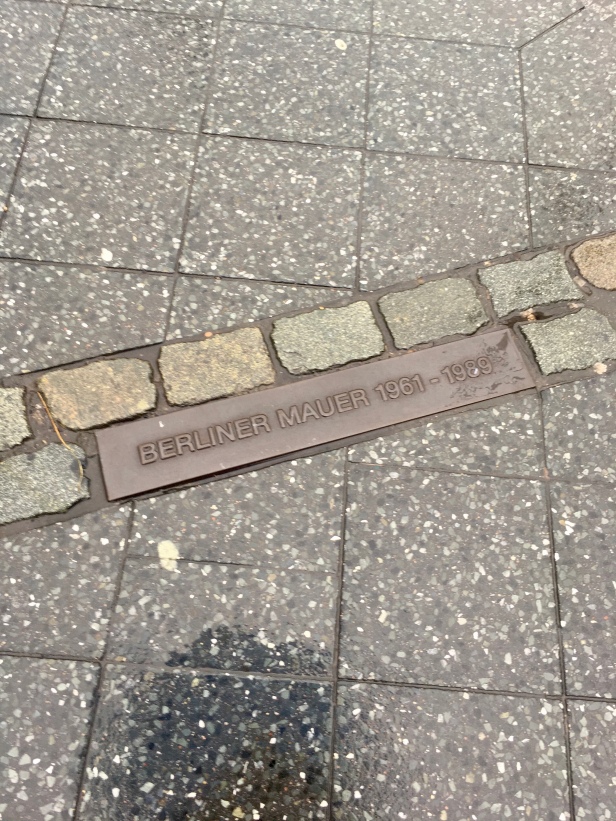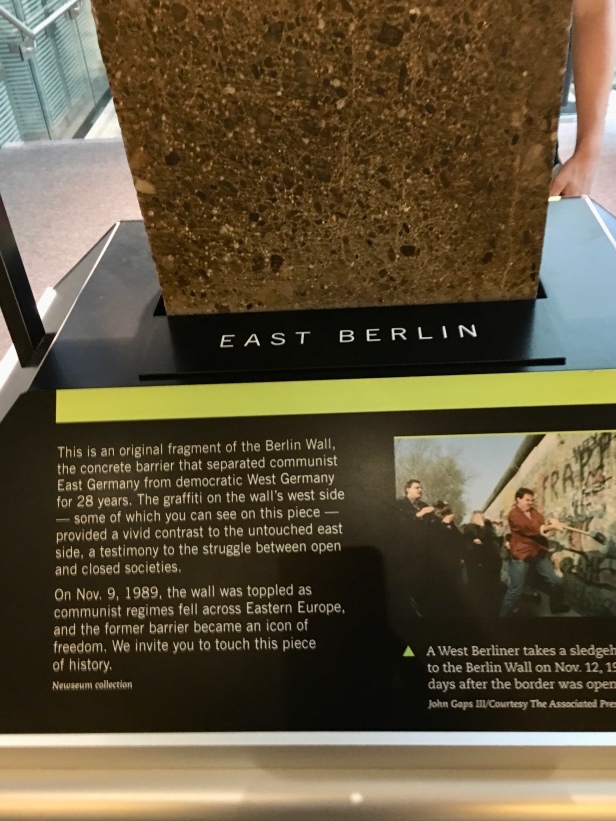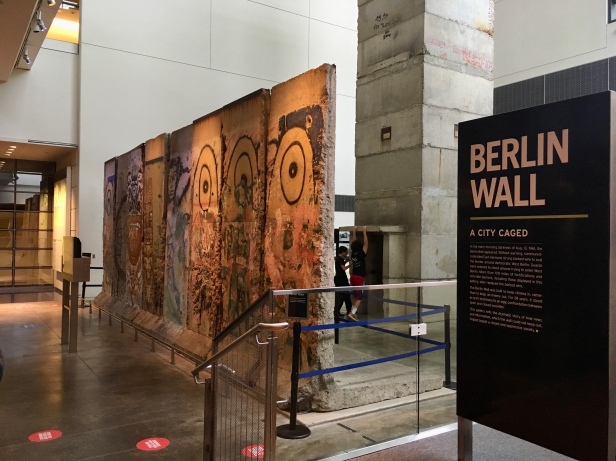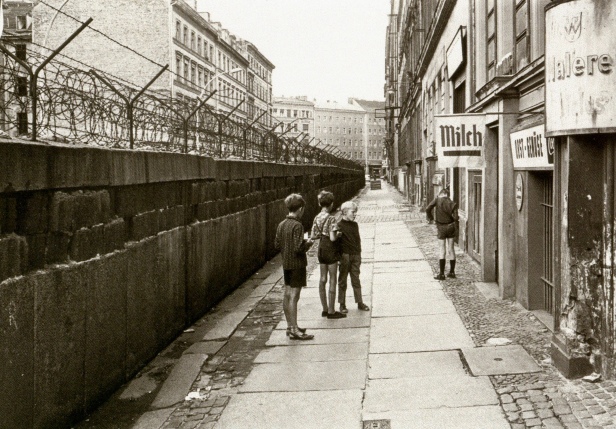Please note: These pictures were taken in February 2020 before travel was restricted due to the COVID-19 pandemic.

I was puzzled at the sight of countless wads of colorful chewed-up gum stuck on the 12-foot (3.6 m) concrete sections of the Berlin Wall near the Bahnhof Potsdamer Platz railway station entrance!
I was expecting to find these concrete slabs protected from the damaging elements of dirt and rain, as well as, time. After all, these are historic artifacts.
Soon my puzzlement was replaced by awe. The fact that I could see such detail in 3-D meant that I was here, looking at a piece of history that I had only seen in textbooks!
Reading the information panels about the Berliner Mauer jogged my memory about what I had learned about it in school.
The Berlin Wall
On August 13, 1961, East German soldiers laid down barbed wire to stop movement between West Berlin and East Berlin. Its purpose was to prevent East Germans (living under communism) from using West Berlin as a gateway to West Germany (which was democratic). Construction on the Wall with concrete began two days later. The Wall’s length around all of West Berlin was 96 miles/155 km.

November 9, 1989 is known as the date the Berlin Wall fell. However, active demolition of it didn’t begin until the following summer. Since then, numerous museums, libraries, universities, parks, and gardens around the world have acquired sections of the Wall. Today, these sections stand as symbols of triumph over repression.
For instance, the largest section of the Wall outside of Germany was located in Washington, DC, in the now-closed journalism museum, Newseum.
The Berlin Wall at Newseum in Washington, DC
During my visit to Newseum in 2017, I got to see remnants of the Wall, as well as a 32-foot tall watchtower that stood near Checkpoint Charlie.





As moving as it was to see remnants of the Wall in the museum, nothing compares to seeing the Wall where it actually stood for nearly three decades.
The Berlin Wall on Bernauer Straße
In addition to Bahnhof Potsdamer Platz, I got to see a section of the Berlin Wall along Bernauer Straße:

The side with art and writing on it faced West Berlin while the unmarked side faced East Berlin.



The Death Strip was the place where East German guards were instructed to fatally injure anyone trying to flee. At least 139 people are known to have lost their lives trying to escape.
In between the border of East Berlin to the wall (shown above) were several other obstacles, including a ditch, a sandbank, watchtower, guard dogs, spikes on the ground, and an electrified wire fence.
In addition, the tops of the Wall were curved to prevent people from climbing over.
Inside the Documentation Center, visitors get a glimpse into the period of 1961-1989 through interactive displays of photographs, news reels, audio clips, maps, as well as movie clips that featured the Berlin Wall.


Postcard: Children in West Berlin, 1966


The way I see it: As the boys are doing the wholesome act of buying milk (“Milch”) from a store next to the Berlin Wall, the image illustrates innocence maintained and going about normal life despite abnormal conditions.
My related posts on Visiting Berlin in February 2020:
- Visiting Berlin: Where to Eat
- Visiting Berlin: Pariser Platz and the Brandenburg Gate
- Visiting Berlin: ‘Like You! Friendship – Digital and Analogue’ Exhibition at the Museum für Kommunikation


Looking forward to reading more about your just-in-time (before Covid) visit to Berlin.
LikeLiked by 1 person
Thank you, Don. Before we left, I remember checking travel advisories every day hoping we wouldn’t have to cancel plans. So happy I got to visit my dear friend in Berlin before travel restrictions and lockdown!
LikeLiked by 1 person
I once had a large chunk of the wall but chipped so much away to give to friends who wanted a piece, I finally was left with something the size of a match box haha
LikeLiked by 1 person
Wow, I think a matchbox-sized piece is pretty big. I remember seeing some Berlin postcards for sale that came with a piece of the Wall (the size of a pebble!), but I didn’t buy any.
LikeLiked by 1 person
Ha, yes, people chipped away some very big pieces and were still doing so when I visited Potsdamer Platz in ’90.
LikeLiked by 1 person
Fascinating – how did people carry the chunks around? I imagine they were heavy! So cool you were there in ’90!!
LikeLiked by 1 person
Folk literally carried bits away in two hands – even pieces over a foot square!
LikeLiked by 1 person
Oh my goodness!
LikeLiked by 1 person
Crazy eh but that is what it was like then. When I visited again years later, most of the wall had gone and Potzdamer being redeveloped and the market sellers sold small pieces of the wall in resin! Gahh.
LikeLiked by 1 person
That’s it – the Wall pieces I’d seen with postcards must’ve been in resin (are they real?!) I read how the Sony Center was built in Potsdamer Platz as part of the redevelopment in 2000!
LikeLiked by 1 person
I really do not know but the cynic in me thinks that some enterprising soul is now selling pieces of a wall rather than the wall 😉
I think when they redeveloped it, they found one of Hitler’s bunkers which was previously unknown!
LikeLiked by 1 person
I hear you, that was also the cynic in me wondering about the Wall “souvenirs” 😉 Oh, so Hitler had more than one bunker? I wonder if there are others yet to be discovered…
LikeLiked by 1 person
Yes. it’s amazing the history that might still be hidden beneath our feet! 😉
LikeLiked by 2 people
We also enjoyed visiting Berlin and viewing the remainder of the Wall. Thank you for sharing.
LikeLiked by 1 person
I’m glad you enjoyed your visit to Berlin! Thank you for reading!
LikeLiked by 1 person
I visited the Berlin Wall in 2012, and I was actually disappointed at how short and fragmented it was; I’d anticipated it to be a grand, towering, and intimidating artifact, but it looked as if much of it was torn down over the past 30+ years…all the same, the Berlin Wall remains a testimony to the Cold War days, and it really is an educational site to take in when one’s in the German capital!
LikeLiked by 1 person
I know what you mean. I think popular media give the impression that the entire Wall was sky-high. But you’re right, some sections were shorter, like the one shown on the postcard, where the Wall doesn’t look much taller than the young boys! So much history there. I’d love to go back to Berlin and explore more.
LikeLiked by 2 people
i’ve been there!
LikeLiked by 2 people
😊
LikeLiked by 1 person